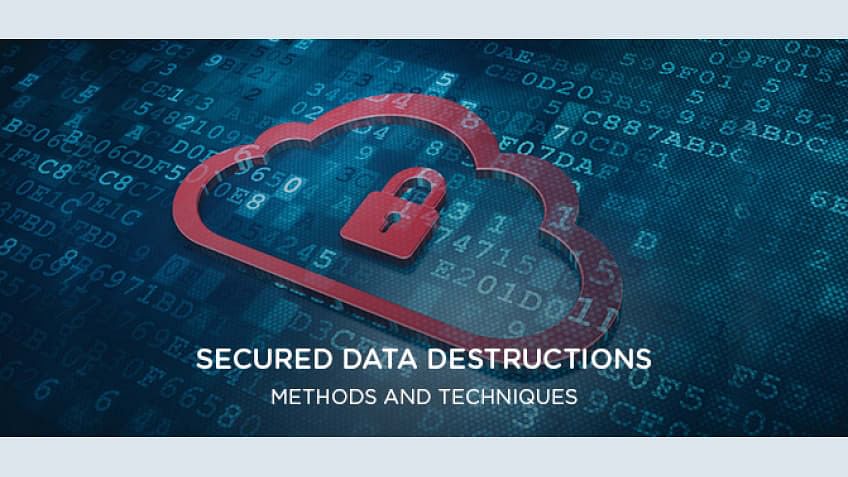Exploring the Significance of Information Damage in the Context of Computer Security Services and Protecting Confidential Information
In an era where information violations are increasingly typical, the significance of effective data destruction can not be overemphasized. Organizations should embrace strict steps to guarantee that sensitive details is not just secured throughout its lifecycle however additionally emphatically eliminated when no much longer necessary. The approaches utilized for data obliteration, coupled with compliance to lawful standards, play an essential function in maintaining discretion and depend on. The implications of these practices extend past mere conformity, influencing a business's credibility and functional integrity in the digital industry. What techniques can companies execute to boost their data devastation protocols?
Understanding Information Devastation
Data damage is a critical part of computer protection that involves the permanent elimination of information from storage space tools to prevent unauthorized gain access to and possible information violations. In an increasingly electronic landscape, companies encounter heightened risks related to delicate details being improperly accessed or made use of. Efficient information devastation safeguards against these dangers, ensuring that personal dataâEUR" such as consumer information, intellectual home, and economic recordsâEUR" can not be recovered after disposal.
Recognizing the significance of information damage expands beyond plain compliance with legal and regulatory structures; it is crucial for preserving organizational stability and trust fund. When information is incorrectly taken care of or improperly ruined, the repercussions can be serious, including economic loss, reputational damages, and legal obligations.

Approaches of Information Obliteration

One common method is information cleaning, which involves overwriting existing information with arbitrary patterns multiple times. This technique makes the initial information irretrievable, making it a popular choice for organizations looking for to shield secret information.
An additional approach is degaussing, which uses an effective electromagnetic field to disrupt the magnetic domain names on storage gadgets, properly eliminating the information. This technique is specifically effective for magnetic media but is not suitable to solid-state drives.
Physical destruction is an additional durable method, crushing or involving the shredding of storage space tools. This approach guarantees that information recovery is basically impossible, making it excellent for very delicate information.
Finally, file encryption can act as a complementary technique to information removal. By encrypting information prior to removal, organizations can add an extra layer of safety and security, guaranteeing that even if remnants are recuperated, they stay unattainable without the decryption key. Each method should be selected based upon the degree of information level of sensitivity and the particular safety demands of the company.
Legal Compliance and Information Safety
Organizations should browse a complicated landscape of lawful demands connected to data security, particularly after executing approaches of data eradication. Different regulations, such as the General Data Defense Policy (GDPR) and the Medical Insurance Transportability and Responsibility Act (HIPAA), enforce strict guidelines on exactly how organizations have to get rid of and deal with of sensitive data. Failure to abide with these regulations can lead to substantial lawful repercussions, consisting of substantial penalties and reputational damages.
Information devastation procedures should be carefully recorded to demonstrate compliance with applicable laws and standards. This documents not just acts as evidence of adherence to legal obligations but also highlights a commitment to safeguarding delicate info. Organizations should likewise establish clear policies concerning data retention and damage timelines, ensuring that data is not held longer than necessary.

Furthermore, regular audits and assessments of data destruction practices are vital to maintain conformity and adjust to progressing lawful structures (data destruction). By proactively resolving legal needs, companies can alleviate dangers related to information violations and show their dedication to data safety. Eventually, prioritizing lawful conformity in data damage processes is not simply you can try here a regulatory commitment, but an essential facet of a robust information safety method
Effect On Organization Online Reputation
The reputation of an organization can be dramatically influenced by its technique to data damage and monitoring. In today's digital landscape, where data breaches can take place anytime, the failure to correctly throw away sensitive information can cause extreme repercussions. Organizations that improperly take care of data destruction danger revealing private client details, which not only breaches personal privacy legislations however likewise erodes depend on among clients and stakeholders.
A damaged online reputation can result in reduced client commitment, as clients become hesitant to involve with an organization that has demonstrated neglect in securing their data. Negative promotion surrounding an information breach can have a long-term impact, as prospective clients might be prevented by the perceived lack of protection. This can result in a straight decrease in profits and market share.
Additionally, companies that focus on data devastation as component of their protection method can enhance their credibility by showcasing their commitment to guarding delicate info. By embracing stringent data management practices, companies can not only alleviate dangers but also place themselves as reliable entities in their particular markets, consequently strengthening their overall brand photo.

Finest Practices for Secure Disposal
Applying best practices for protected disposal of information is necessary for minimizing threats related to information breaches and making sure conformity with privacy policies. Organizations needs to adopt a comprehensive data disposal plan that lays out treatments for both physical and digital data damage.
For physical information storage space tools, such as disk drives, shredding or degaussing is recommended to avoid data recovery. Furthermore, companies ought to maintain a chain of custody documents during the disposal procedure, making sure liability and traceability of disposed things.
For electronic information, using software program that adheres to industry criteria for data cleaning is crucial. This software application ought to overwrite existing data several times, making recovery basically impossible. It is additionally essential to verify the effectiveness of the data devastation procedure with audits or third-party analyses.
Training workers on protected disposal methods includes another layer of safety and security, as human error can usually bring about information direct exposure. On a regular basis updating and reviewing disposal plans makes certain placement with progressing regulations and technical developments. By applying these best methods, companies can significantly minimize the danger of unauthorized information accessibility and boost their total information security strategy.
Verdict
To conclude, data damage is a basic aspect of computer system safety services that guarantees the defense of personal info from unauthorized gain access to. Executing effective techniques of information elimination, sticking to legal compliance, and recognizing the effect on organization track record are essential elements of a comprehensive data safety and security technique. By taking on finest practices for secure disposal, organizations can foster trust fund with clients and secure delicate data, eventually contributing to a much more secure electronic landscape.
In site an age where information breaches are look at this web-site significantly common, the importance of effective information damage can not be overemphasized.Information damage is a vital component of computer security that includes the long-term removal of data from storage devices to avoid unapproved access and possible data breaches. Organizations needs to also develop clear plans concerning data retention and devastation timelines, guaranteeing that data is not held longer than necessary.
By proactively resolving lawful demands, companies can mitigate threats connected with data violations and show their dedication to information protection (data destruction). Ultimately, focusing on legal compliance in data devastation procedures is not just a regulative obligation, however a fundamental facet of a durable information safety and security approach